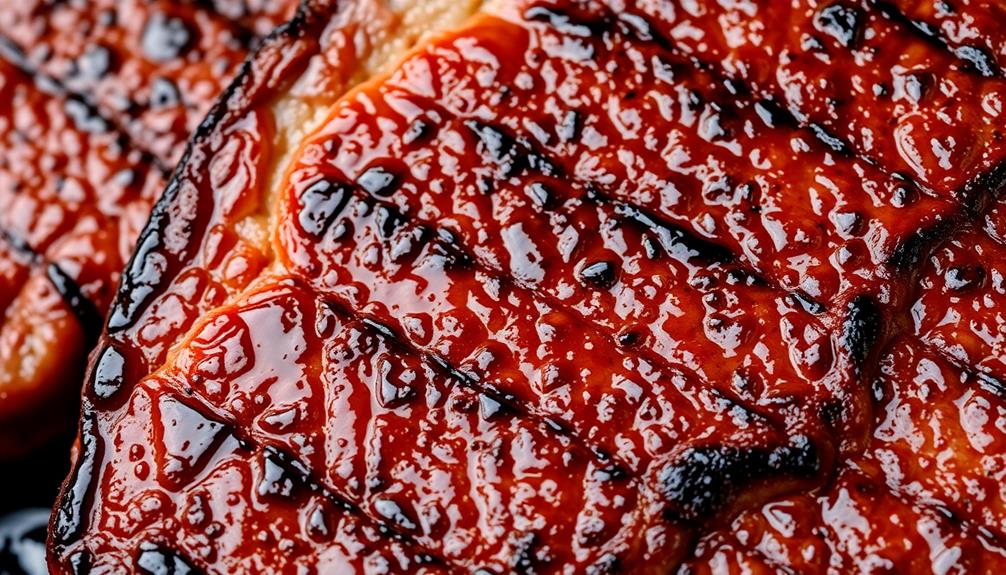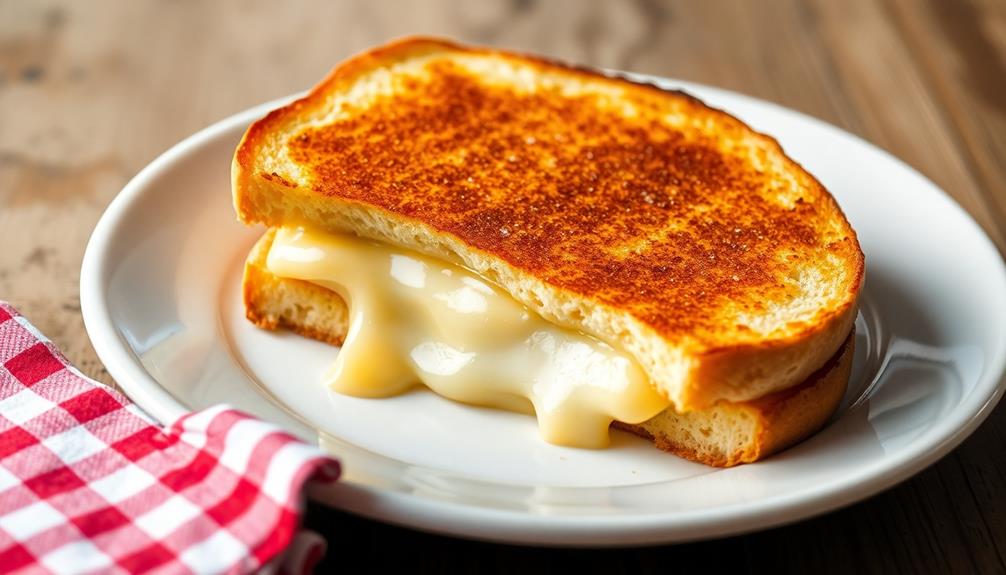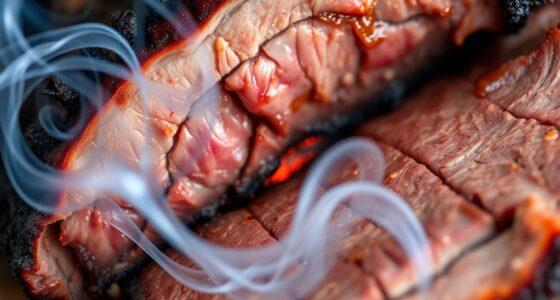The Maillard reaction is a complex chemical process that transforms the flavors and appearance of cooked foods. Discovered in 1912, this reaction occurs between amino acids and reducing sugars, resulting in the rich browning, enticing aromas, and delectable tastes you love. It's essential for culinary excellence, influencing everything from seared meats and roasted vegetables to coffee and chocolate. You can harness the power of the Maillard reaction by cooking at high temperatures, keeping meats dry, and allowing for proper rest times. Dive deeper into this fascinating chemistry and unlock the secrets to elevating your own cooking.
Key Takeaways
- The Maillard reaction is a complex chemical process between amino acids and reducing sugars that is responsible for the browning, flavor development, and aroma creation in cooked foods.
- The Maillard reaction is essential for achieving culinary excellence, enhancing the sensory experience of meals, and influencing a wide range of foods, including meats, baked goods, coffee, and chocolate.
- High cooking temperatures, dry surfaces, and proper cooking techniques are crucial for maximizing the Maillard reaction and achieving desired flavor and color profiles in dishes.
- The Maillard reaction plays a significant role in consumer perception and enjoyment of food, contributing to the unique flavor profiles and desired textures in various culinary traditions.
- Ongoing research continues to explore the nuances of the Maillard reaction, providing insights that can help improve cooking techniques and enhance the overall quality of cooked foods.
History
The Maillard reaction was first discovered in 1912 by French chemist Louis-Camille Maillard. Maillard observed that when amino acids and reducing sugars were heated together, they underwent a complex series of chemical reactions that produced hundreds of different flavor compounds.
This process, now known as the Maillard reaction, is responsible for the distinctive aromas and flavors of many cooked foods, from roasted meats and baked breads to coffee and chocolate.
Over the past century, scientists have continued to study the Maillard reaction in depth, unraveling its intricate chemistry and understanding its role in food preparation and processing.
They've found that the specific compounds produced depend on factors like temperature, pH, and the types of amino acids and sugars involved.
The Maillard reaction is now recognized as a fundamental phenomenon in food science, with applications in areas like flavor development, color enhancement, and nutrient retention.
Recipe
The Maillard reaction is a chemical process that occurs when foods are cooked at high temperatures, resulting in the development of hundreds of different flavor compounds. This complex reaction is responsible for the delicious aromas and flavors associated with many of our favorite cooked dishes, from crispy-skinned roasted meats to golden-brown baked goods.
In this recipe, we'll explore how to harness the power of the Maillard reaction to create a flavorful and visually appealing dish. By carefully controlling the cooking temperature and time, we can unlock the full potential of this fascinating chemical process.
Ingredients:
- 4 boneless, skinless chicken breasts
- 2 tablespoons olive oil
- 1 teaspoon garlic powder
- 1 teaspoon onion powder
- 1 teaspoon paprika
- Salt and pepper to taste
Cooking Instructions:
Preheat your oven to 400°F (200°C). Pat the chicken breasts dry with paper towels and season them evenly with the garlic powder, onion powder, paprika, salt, and pepper.
Heat the olive oil in a large, oven-safe skillet over medium-high heat. Sear the chicken breasts for 2-3 minutes per side, or until they develop a golden-brown crust. Transfer the skillet to the preheated oven and roast the chicken for 15-20 minutes, or until the internal temperature reaches 165°F (75°C).
Tips:
To maximize the Maillard reaction, it's important to ensure the chicken is dry before searing. This will help create a crisp, caramelized surface.
Additionally, allowing the chicken to rest for a few minutes before slicing will help the juices redistribute, resulting in a more tender and flavorful final dish.
Cooking Steps
Preheat your oven to 400°F.
Coat the meat with seasoned flour, then sear it in a hot pan.
Bake the meat in the oven and let it rest before serving.
Step 1. Preheat Oven to 400°F
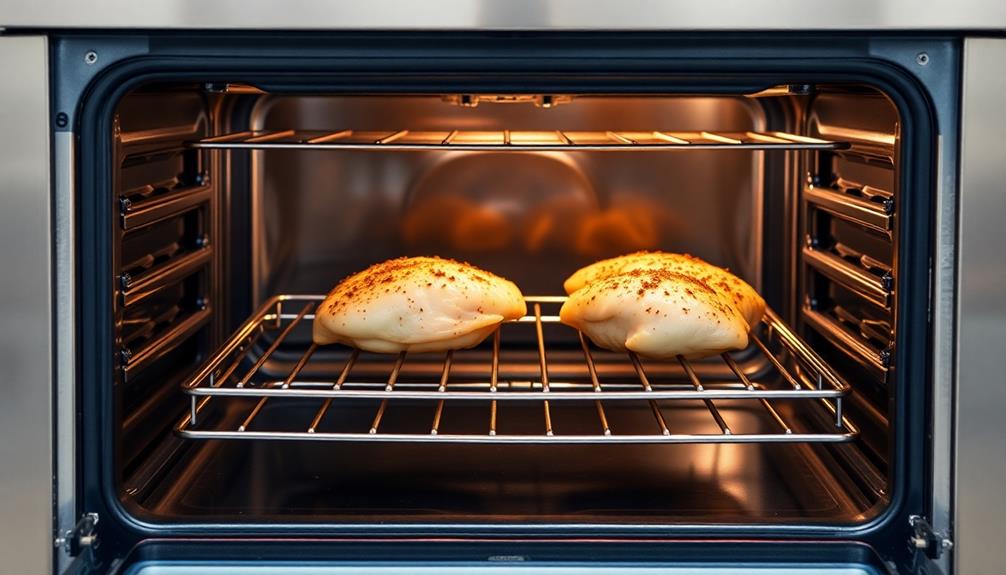
Before you can begin baking, it's important to preheat your oven to 400°F. This temperature is crucial for the Maillard reaction to occur effectively.
As the oven heats up, the air inside will become hotter and drier, creating the perfect environment for the chemical reactions that produce the rich, complex flavors and appetizing brown color we associate with baked goods. This process, known as the Maillard reaction, is responsible for the delicious aromas and flavors that emanate from the oven as our favorite dishes bake. The same reaction is what gives the bestloaded baked potato recipe its irresistible golden crust and savory taste. Understanding the science behind baking can help home chefs to master the art of creating mouthwatering, perfectly cooked dishes.
Additionally, ensuring the kitchen is well-ventilated can enhance the cooking process, much like how regular cleaning is essential for optimal performance in air purifiers.
Once the oven has reached the desired temperature, you'll want to wait a few minutes to ensure it's fully stabilized. This helps maintain a consistent temperature throughout the baking process, which is essential for achieving even cooking and browning.
Remember to use an oven thermometer to verify the temperature, as relying on the oven's display alone can be inaccurate.
Step 2. Coat Meat With Seasoned Flour
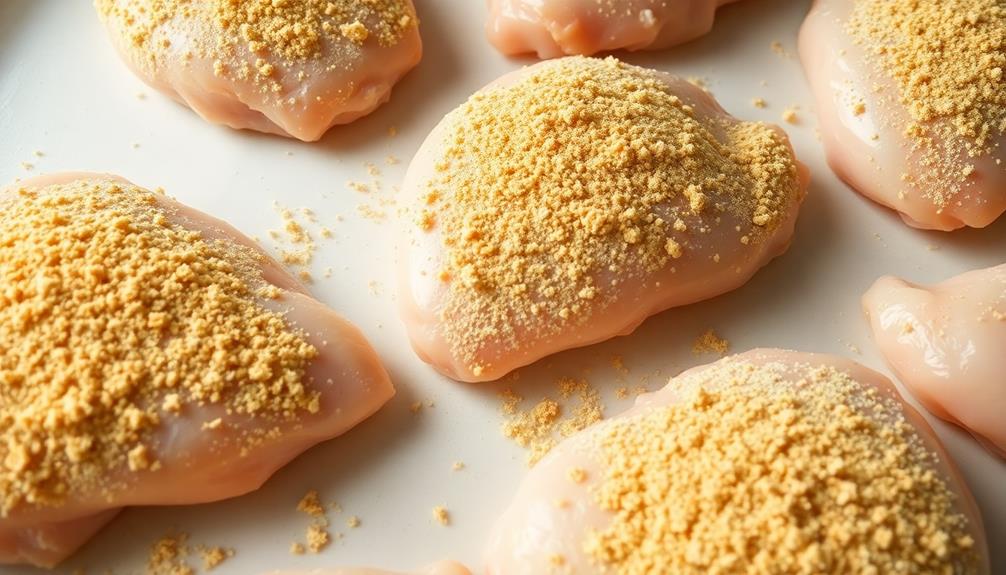
Having preheated your oven to the optimal 400°F, you'll now want to coat the meat in a seasoned flour mixture. This serves a dual purpose – it helps create a delightful, crispy crust on the exterior of the meat, while also thickening the natural juices to make a tasty gravy.
Start by combining all-purpose flour, salt, pepper, and any other desired spices in a shallow bowl. Using your hands or a pair of tongs, thoroughly coat the meat on all sides with the seasoned flour. Ensure every nook and cranny is covered, as this will maximize the Maillard reaction and result in the most flavorful crust.
With your meat now coated, you're ready to transfer it to a baking sheet or roasting pan. Make sure to shake off any excess flour before placing the meat in the preheated oven. This will prevent the flour from burning and creating a bitter taste.
Get ready for the magic of the Maillard reaction to begin!
Step 3. Sear Meat in Hot Pan
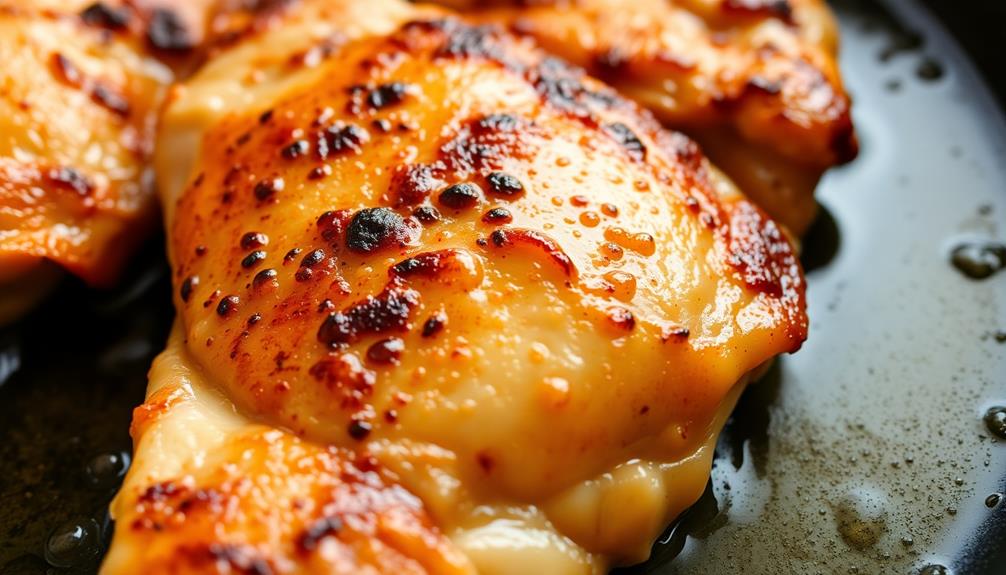
Once the meat is coated, you'll want to sear it in a hot pan. Heat a large skillet or cast-iron pan over high heat until it's ripping hot.
Add a bit of oil to the pan, and let it shimmer. Carefully place the coated meat in the pan, making sure not to crowd the pieces. This ensures even browning.
Let the meat sear undisturbed for 2-3 minutes, until a golden-brown crust forms. Flip the pieces and sear the other side. The high heat creates the perfect conditions for the Maillard reaction to occur, caramelizing the sugars and proteins on the surface and developing that rich, savory flavor.
Once the meat has a nice sear all over, you can lower the heat and continue cooking to your desired doneness. Searing locks in the juices and creates a wonderful texture contrast between the crisp exterior and tender interior.
Don't skip this crucial step – it's the key to unlocking the Maillard magic.
Step 4. Bake Meat in Oven
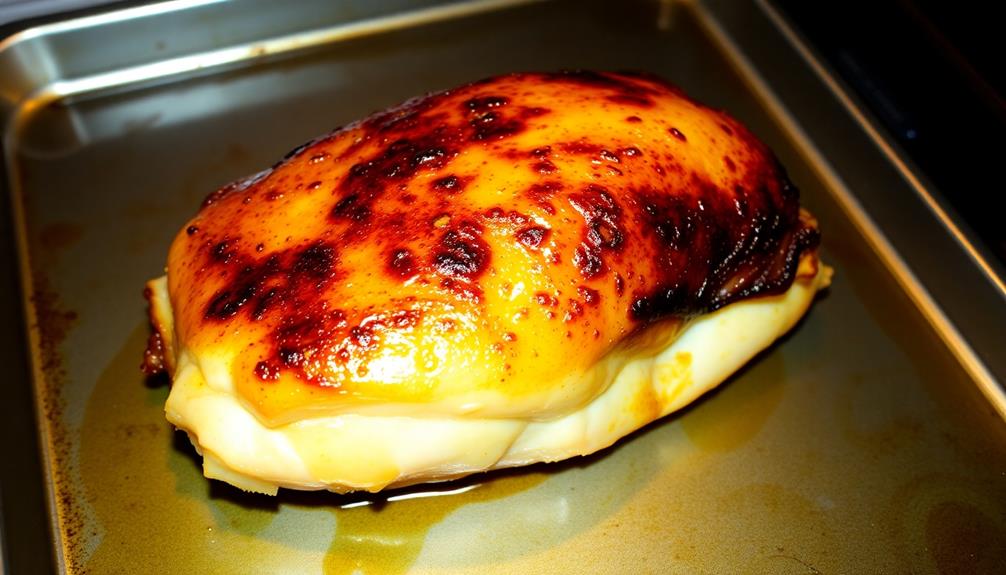
With the meat seared to perfection, the stage is set for the next step – baking it in the oven. Preheat your oven to the desired temperature, usually between 375°F and 425°F, depending on the cut of meat and your preferred level of doneness.
Interestingly, baking can also enhance flavors in a way similar to how coffee enhances athletic performance, as the Maillard reaction continues to develop rich, complex flavors in the meat.
Place the seared meat on a rimmed baking sheet or in a shallow roasting pan, ensuring it's not overcrowded. This allows the hot air to circulate freely, promoting even cooking.
As the meat bakes, the Maillard reaction continues, further deepening the flavor and creating a delectable crust. Keep a close eye on the meat, basting it occasionally with the pan juices to maintain moisture.
Use a meat thermometer to monitor the internal temperature, removing the meat from the oven when it reaches your target doneness. Allow the meat to rest for a few minutes before slicing, enabling the juices to redistribute throughout the cut.
This oven-baking technique leverages the power of the Maillard reaction to elevate the meat's taste and texture.
Step 5. Let Meat Rest Before Serving
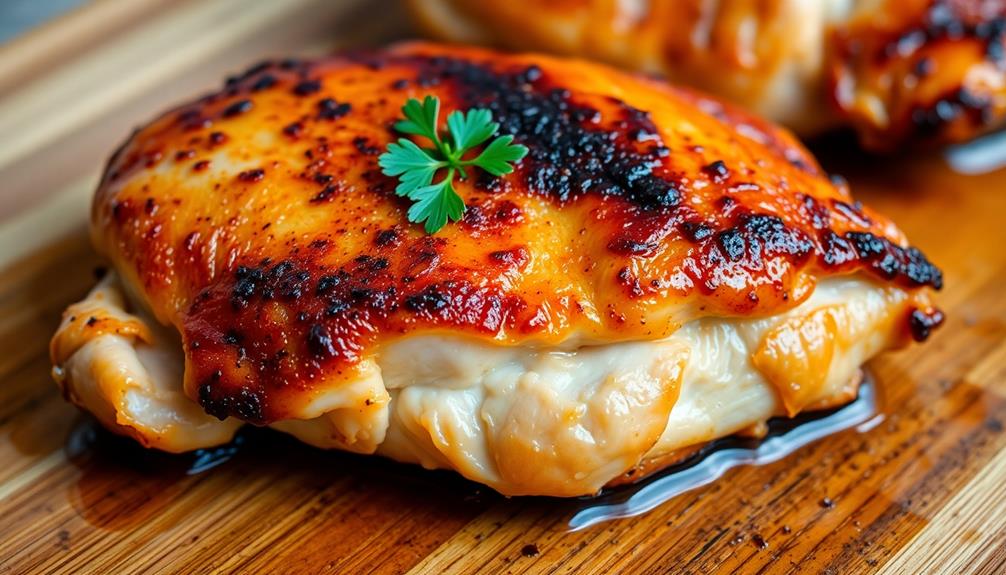
After the meat has finished baking in the oven, don't rush to slice into it. Allow it to rest for about 10-15 minutes. This resting period is crucial as it allows the juices to redistribute throughout the meat, making it moist and tender.
If you cut into the meat right away, those precious juices will spill out, leaving you with a dry, disappointing dish.
During the resting time, the temperatures inside the meat will continue to rise, bringing the meat to its desired level of doneness. This carryover cooking is an important factor to consider, as it can affect the final texture and flavor of the dish.
To ensure your meat is cooked to perfection, use a meat thermometer to check the internal temperature before removing it from the oven, then let it rest as directed.
This simple step can make all the difference in creating a juicy, flavorful meal your guests will rave about.
Final Thoughts
The Maillard reaction's intricate dance of molecules and flavors is a captivating subject that continues to intrigue food scientists and enthusiasts alike.
As you've learned, this complex chemical process is responsible for the mouthwatering aromas and rich, caramelized hues that elevate our favorite dishes. From seared steaks to freshly baked breads, the Maillard reaction is the unsung hero, transforming simple ingredients into culinary masterpieces.
While we've only scratched the surface of this remarkable phenomenon, one thing is clear – the Maillard reaction is a testament to the incredible complexity of the food we enjoy.
As you continue your culinary journey, keep this knowledge in mind. Experiment, observe, and marvel at the alchemy that takes place in your kitchen.
For it's through a deeper understanding of the Maillard reaction that we can unlock the full potential of the ingredients we love, creating dishes that not only nourish the body but also delight the senses.
The possibilities are endless, so embrace the science and let your creativity soar.
Frequently Asked Questions
What Is the Optimal Temperature Range for the Maillard Reaction?
The optimal temperature range for the Maillard reaction is typically between 285°F (140°C) and 320°F (160°C). This temperature range allows for the complex chemical reactions that create the distinctive flavors and colors associated with browned foods.
How Does the Maillard Reaction Affect the Nutritional Value of Food?
The Maillard reaction can impact the nutritional value of food both positively and negatively. It can improve flavor and appearance, but it can also reduce the bioavailability of certain nutrients like amino acids and vitamins.
Can the Maillard Reaction Be Used to Enhance the Flavor of Plant-Based Foods?
Yes, the Maillard reaction can be used to enhance the flavor of plant-based foods. By carefully controlling the temperature and time, you can create delicious, complex flavors that make plant-based dishes even more appealing.
How Does the Maillard Reaction Differ Between Dry and Wet Cooking Methods?
The Maillard reaction differs between dry and wet cooking methods. In dry cooking, it's more intense, creating deeper, richer flavors. In wet cooking, it's less pronounced, yielding more subtle taste changes.
What Are the Health Implications of Over-Browning Food Due to the Maillard Reaction?
Overcooking food can lead to the formation of harmful compounds like acrylamide and heterocyclic amines, which may increase your risk of certain health issues like cancer. It's best to avoid heavily browned or charred foods.
